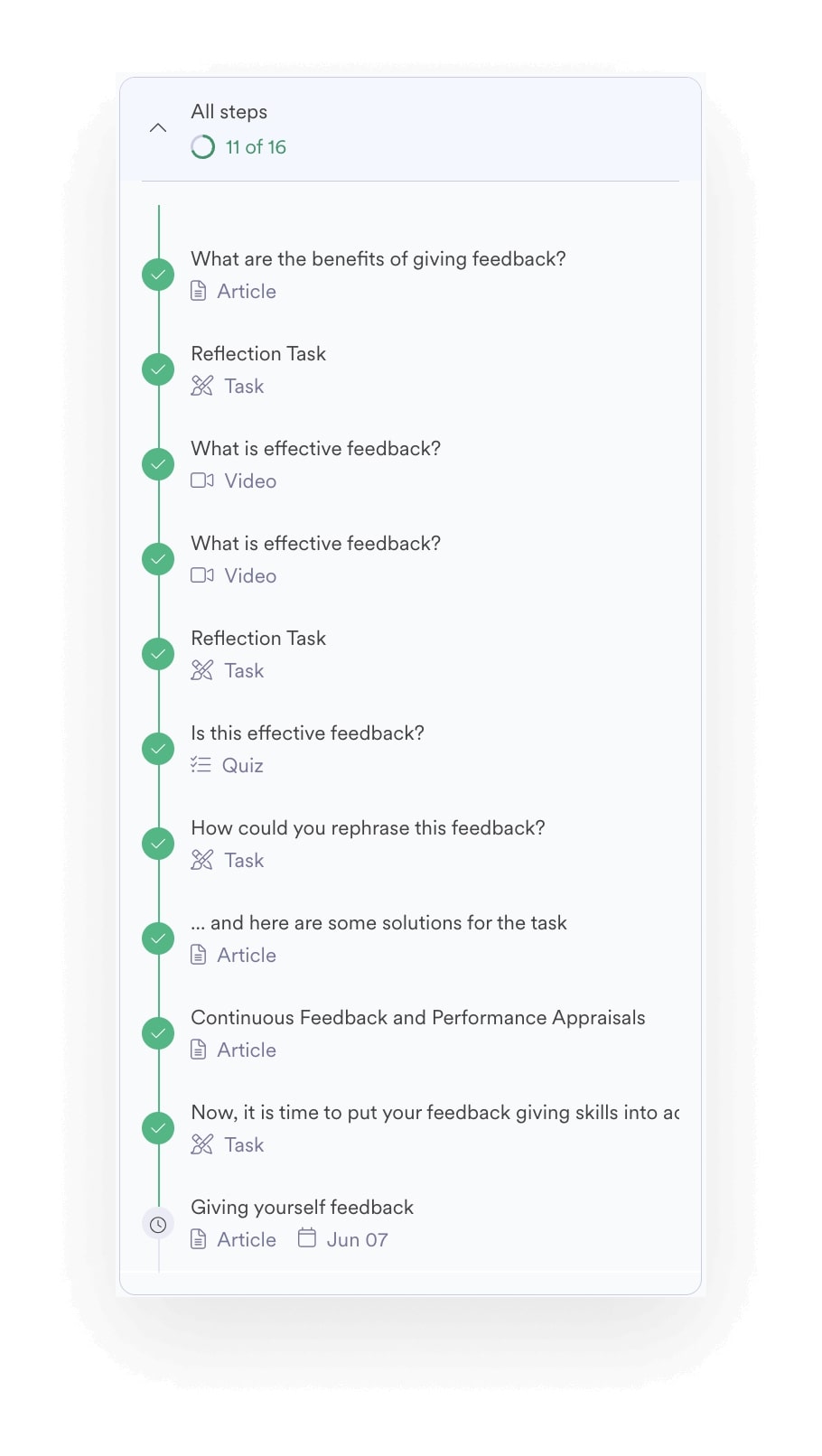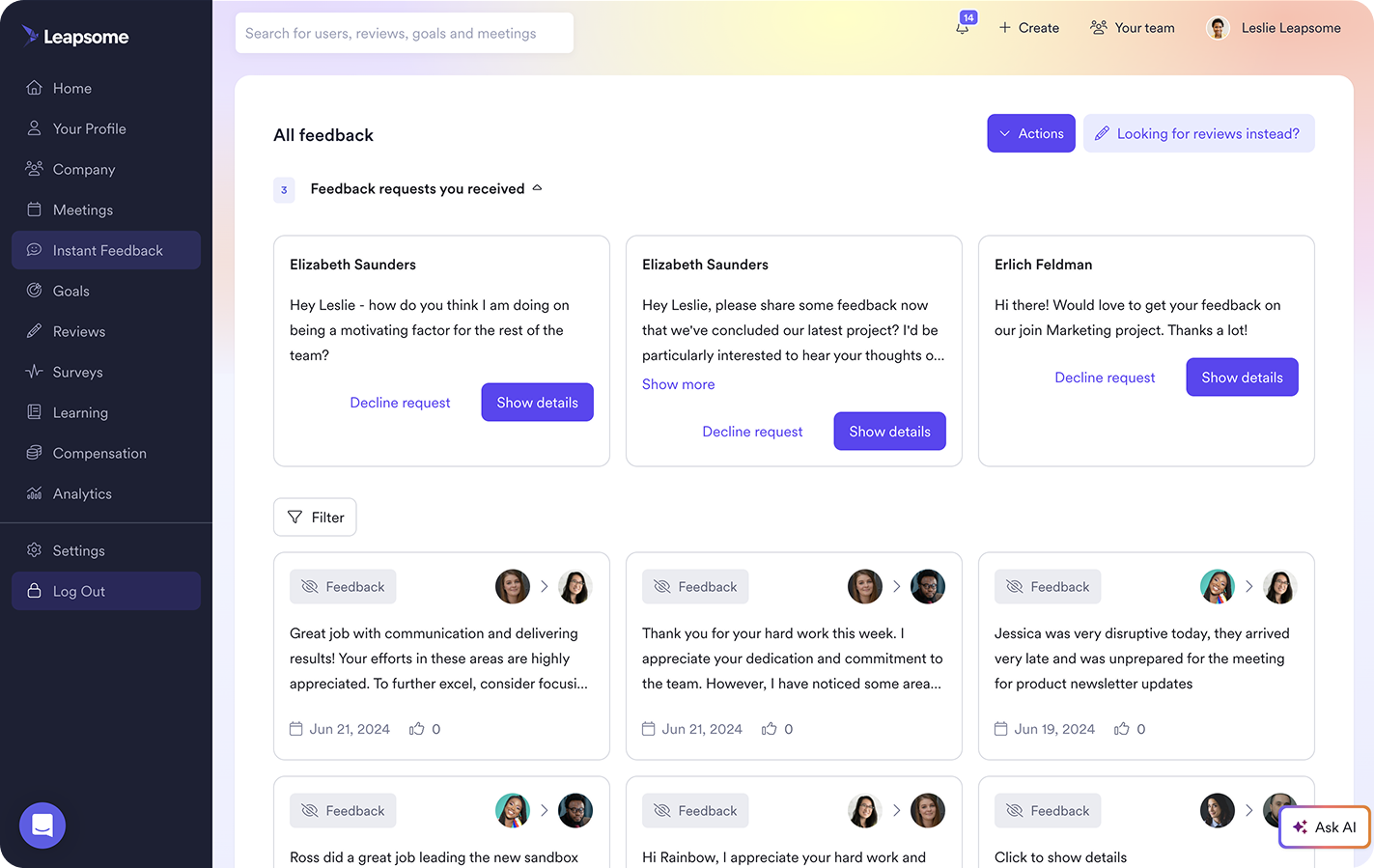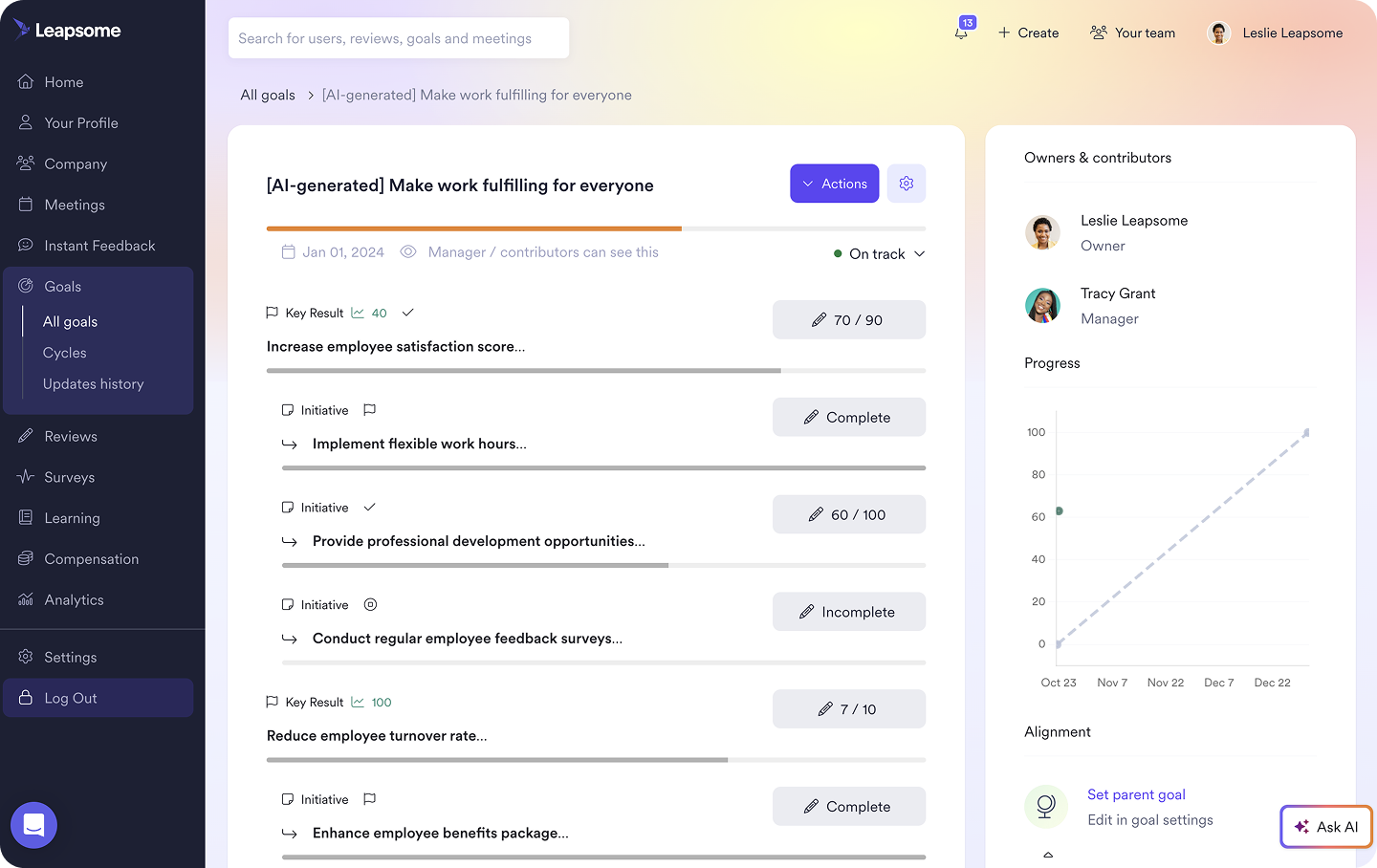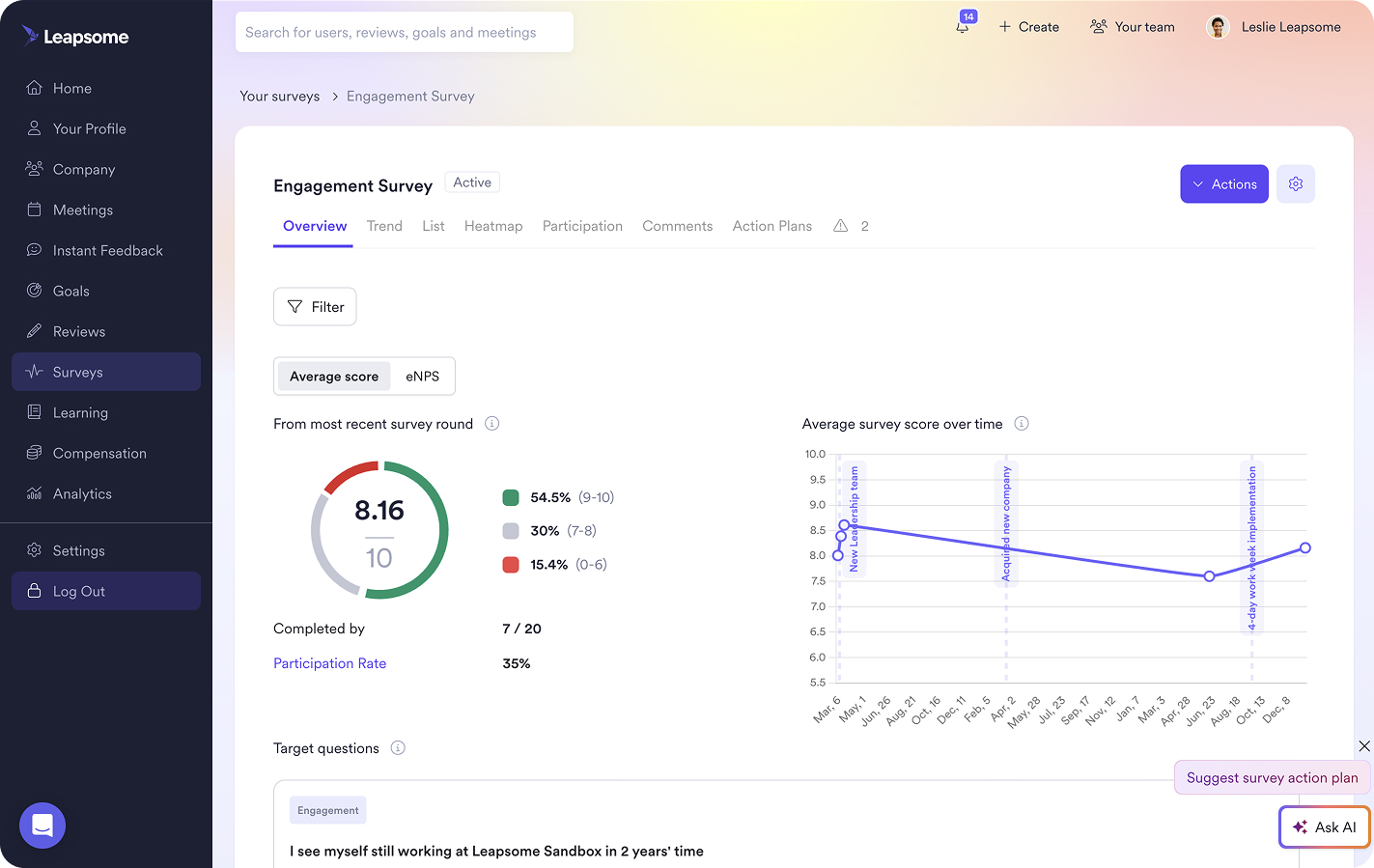Measuring employee engagement: 10 metrics & KPIs to track in 2026

Gallup research shows that employee engagement is on the rise. That doesn’t mean it’s time for organizations to relax their efforts around improving and measuring employee engagement, though. (1) According to the same report, teams are still reporting record-high stress levels, and only 28% of remote workers say they feel connected to their company’s mission and purpose. Even in this context, recent Leapsome data found that only one in three HR leaders track metrics like engagement and turnover (2).
Why does this matter? Engaged employees tend to feel more motivated and energized by their work and collaborate more effectively with their teams, leading to beneficial business outcomes, such as increased productivity and profitability and reduced turnover. Higher engagement can even boost your company’s earnings per share (3).
That’s why measuring engagement should be a top priority for organizations focused on staying competitive. With reliable metrics and KPIs, HR leaders and company decision-makers can make more data-informed choices for their people.
Data is powerful, which is why in this article, we break down ten key engagement metrics, exploring why each one is key to driving your business forward.
- Gallup, 2023
- Leapsome Workforce Trends Report, 2023
- Gallup, 2023
🚀 Learn what motivates employees with easy-to-set-up surveys!
Discover the powerful insights you need to enhance team member happiness and create a healthy workplace culture.
👉 Learn more
What are employee engagement metrics?
Employee engagement metrics are quantitative and qualitative measures used to assess how connected employees feel to their work on an emotional, mental, and physical level. These metrics help organizations identify areas for improvement, implement an effective employee engagement strategy, and track progress over time.
There are many ways to measure employee engagement, but common metrics include:
- The Employee Net Promoter Score (eNPS)
- Retention rates
- Absentee rates
- Survey participation
- Survey scores
- Utilization of benefits and perks
Why should you track employee engagement metrics?
Employee engagement tracking allows you to understand how your people feel about their role, their working environment, their leadership, and the company’s mission. This way, you can make intentional, data-informed changes when necessary.
We also can’t ignore the ROI of measuring employee engagement. Gallup data has shown that companies with higher engagement data also experience:
- 81% fewer occurrences of absenteeism
- 23% higher profitability
- 18% higher productivity
- 10% higher customer engagement
Engagement metrics can also help you identify what employees feel like they’re missing from work.
“Paying people fairly for their work is important,” writes culture consultant and HR strategist Catherine Mattice, “but true engagement is about more. It happens when the workplace has a great culture and people talk to each other with respect and care about each other genuinely.”
How to measure employee engagement: 10 metrics to measure engagement in 2026
We recommend measuring employee engagement with the following metrics, which should allow you to get a deeper understanding of team member sentiment and take inspired action based on employee feedback.
1. Employee Net Promoter Score (eNPS)
The eNPS is an adaptation of the NPS (Net Promoter Score), created in 2003 to measure the popularity of products and services, as well as how likely customers are to recommend them to their personal networks.
As the name suggests, employee NPS measures how likely employees are to recommend their workplace as a good place to work to their friends and family. It’s a widely used metric in part because it’s quick and easy for employees to complete — they only have to answer one simple question: “How likely are you to recommend us as a great place to work to your family and friends?”

How to measure eNPS
Employees can answer on a scale of 0 to 10, with 0 being the least likely, and 10 being the most likely.
You can calculate the final score by comparing the difference between the responses from your promoters — those who give a score of nine or ten — and your detractors — those who give scores of zero to six. Those with scores of seven or eight are generally not counted in the final calculation.
💡 If 40% of your employees scored 9 or 10, 45% scored 7 or 8, and 15% scored 0 to 6, your calculation would be:
40%-15% = 25 = eNPS score of 25
The higher the score, the better.
2. Retention rate
Your employee retention rate is the percentage of employees that stay with your company over a given period. All companies have some degree of churn, as people naturally leave their jobs for various reasons — which may have nothing to do with employee engagement.
However, a high degree of churn and an inability to retain staff indicate deeper problems, such as few professional development opportunities, a lack of DEI (Diversity, Equity & Inclusion) initiatives, an unwelcoming team, or poor work-life balance.
How to measure retention rate
To calculate your company’s retention rate, take the number of employees who have left the company at the time of the survey and divide it by the number of people at the start of a given period.
For example, if 8 people left the company over a given time frame, and you started the same period with 40 people, you’d divide 32 (40-8) by 40 to get 0.8 = 80%.
Keep in mind that very few organizations have a 100% retention rate, and that’s not something you necessarily need to seek; a dynamic company with talented and engaged employees is always likely to see some shifts.

3. Professional development

Happy and successful workplaces take professional development seriously. Few employees, especially talented ones, are satisfied in roles with minimal opportunities for advancement or improvement.
Distilling professional development into a clear metric will mean building objective development goals for each staff member, ideally as part of scalable promotion processes that show their path to moving up in the company.
How to measure professional development
The competencies required to get a promotion are often company-specific and also vary depending on department and skill set.
You can use Leapsome’s Learning module to build out tailored criteria based on flexible templates and set up automated cycles for learning and development. You can then track engagement metrics like completion rates and utilization rates. You’ll also be able to easily check in with employees, see how they score on relevant quizzes and tests, and ask them how they feel about the learning content and its level of difficulty.
Beyond that, we recommend tracking how many employees complete your development courses and monitoring how this affects their individual professional goals.
4. Work-life balance
“Work-life balance” has become a buzzword in recent years, and for good reason: the World Health Organization (WHO) officially categorized burnout as an “occupational phenomenon” in 2019.
Even more concerning is a 2021 study by the WHO and the International Labor Organization, which found that working more than 55 hours per week increases the risk of dying from heart disease or stroke.
This shows that measuring work-life balance isn’t just about retaining employees — it’s about preserving your people's mental and physical health.
How to measure work-life balance
The easiest way to monitor work-life balance is by asking this question in staff surveys: “How satisfied do you feel with your work-life balance on a scale between zero and ten, with zero meaning not at all satisfied and ten meaning completely satisfied?”
But there are other questions you could ask to yield similar responses. For instance:
- How satisfied are you with the amount of time you have outside of work to pursue hobbies or spend time with family and friends?
- How satisfied are you with the time you have outside of work to rest and recharge?
Low scores may indicate that:
- Staff are overworked or held to unrealistic expectations
- HR needs to bring more team members on board
- There’s a culture of presenteeism that needs to be addressed
You can also assess how staff members make use of their PTO, which can indicate how they feel about their workload and ability to take a break.
5. Recognition
It’s essential to create a culture of gratitude for great, consistent work, and acknowledging achievements publicly encourages others to offer praise and recognition, too. A positive work environment doesn’t just increase motivation and engagement — it also reinforces the importance of your company’s core values and skill sets.
However, measuring recognition and ensuring your initiatives have an impact requires strategic, creative thinking.
How to measure recognition
A people enablement platform like Leapsome can help, as it includes features specifically designed to foster appreciation — like a Praise Wall where employees shout out their colleagues based on specific, customizable categories like “Outstanding Work” or “Colleague Support.” To measure recognition, you can roughly calculate how many team members make use of your tools for recognition, then ask them in surveys if they feel those tools are positively impacting their feelings about work.
This employee feedback is also visible to managers via Leapsome’s Manager Dashboard, so leaders can reinforce those same wins during 1:1 meetings and check-ins.

6. Alignment with team OKRs
Engaged employees are those who know, understand, and believe in your company goals, and that’s why team member alignment with organizational objectives is a helpful indicator of employee engagement. However, just because teams and individuals commit to goals at first doesn’t mean they’re staying connected to them over time.
How to measure alignment
Objectives and key results (OKRs) can be quantitative, like “hiring 10 new employees,” or qualitative, like “‘improving listening skills during client calls.” First check for engagement with goals by asking teams and individuals if they understand the why behind your company objectives. Always be willing to make adjustments if employees express confusion.
The same goes for personal development objectives, which managers and direct reports should review during regular 1:1 meetings and development talks.
We recommend aiming for 70% to 80% completion for your goals, as anything higher could lead to overwork and burnout. However, if you discover that employees and teams are regularly having difficulty achieving a 70% or 80% completion rate, that doesn’t mean they’re simply underachieving. That may signal that it’s time to tweak your objectives to make them more realistic and relevant — or to offer your teams extra support and training.

7. Employee engagement survey participation rate
It may seem obvious, but you can’t improve employee engagement with surveys if no one responds to them. Measuring participation rates can be a good indicator of how engaged staff members are — or at least, how much time or inclination they have to take part in company processes.
Low engagement might seem like bad news, but it’s an opportunity for your company to identify opportunities to improve. For example, perhaps you’re submitting surveys too often, or they’re too long for employees to complete.
How to measure employee engagement survey participation rate
Monitoring your employee engagement participation rate is as simple as checking how many employees have completed your surveys. A dedicated tool like Leapsome Surveys tracks survey participation rates automatically, so there’s no need for manual calculations.

8. 1:1 meetings & team check-ins
A thriving company should have a culture of regular manager-employee meetings and team check-ins to build strong internal relationships, provide ongoing development support — and, of course, keep team members engaged in collaboration with their colleagues.
This is especially important at a time when remote and hybrid workers are feeling more disconnected from their teams and companies.
How to measure 1:1 meetings & team check-ins
You can rely on meeting attendance and participation as hard engagement metrics. If attendance is low and team members are reluctant to actively take part in meetings, it may mean you need to assess whether your meetings are focused and productive enough.
Tools like Leapsome’s Meetings module can help with pre-made agenda templates, features to help you keep track of decisions and previous meeting notes, and tools for scheduling meetings automatically.

9. The quality of professional relationships
The quality of the relationships employees have with their colleagues plays a big role in their engagement — even when working across different countries and time zones.
Keeping an eye on how well colleagues are getting along is a good way to ascertain the strength of a team and increase employee engagement.
How to measure the quality of employee relationships
Establishing good team communication is vital, and you can assess how well employees communicate over messaging apps like Slack or Microsoft Teams. When team members use these systems to share praise, it can also boost links between employees. Leapsome’s Continuous Feedback feature can embed this process within your communication channels, making it efficient and intuitive.
To understand how team members are getting along in your department, you might track engagement in different channels or purposefully ask non-work-related questions to spark conversations. You can even tag people who don’t speak up as much to encourage them to get more involved.
10. Uptake & popularity of employee perks
Offering staff perks — like gym memberships or well-being services — can be a great way to boost employee morale.
However, measuring how much staff members actually use their perks can tell you more about employee engagement and willingness to participate.
How to measure the uptake & popularity of employee perks
Regularly check in with staff regarding their use of your perks and benefits. This might include adding a question to your employee engagement surveys, such as:
- How satisfied are you with our employee perks, such as [X, Y, Z]?
- How often do you use [X perk]?
- What perks do you wish we had?
If the team is underutilizing your perks, you could make more effort to promote the benefits you offer or implement a company-wide challenge to encourage usage.
Which employee engagement measurement tools should you use?
There are plenty of effective tools to measure employee engagement on the market, many of which offer essential features like customizable survey templates, automated surveys, detailed analytics, and actionable insights to inform your engagement initiatives.
We’ve researched and compared a few of these software solutions, which include:
- Leapsome — Leapsome is an engagement and performance management platform bringing together powerful features for conducting surveys, gathering employee feedback, streamlining performance reviews, holding more focused meetings, and setting goals and OKRs. Now supported by AI, Leapsome helps you quickly and easily make sense of the data and shows you how to take concrete action on your engagement survey results.
- Officevibe — This platform has a pleasant UI to navigate and offers pulse surveys, anonymous feedback features, 1:1 meeting tools, and employee recognition features to engage your workforce.
- Glint — Glint is a people success platform that enables organizations to measure and improve employee engagement, performance, and retention. It offers customizable surveys, real-time feedback collection, and predictive analytics to help organizations identify areas for improvement and drive positive change.
- Qualtrics EmployeeXM — Qualtrics EmployeeXM is a comprehensive employee experience management platform that includes employee engagement surveys, feedback collection, and data analytics. It offers customizable survey templates, real-time dashboards, and advanced analytics to help organizations understand and improve employee engagement.
Go from manual to automated engagement tracking with Leapsome
.jpeg)
Synthesizing open-ended survey data and gauging employee sentiment has never been faster with Leapsome’s Surveys module.
It may not be practical to measure all ten of these metrics at once. Instead, we recommend choosing those that feel most feasible at a time. You can also choose a few specific metrics to monitor when it’s most relevant, like periods of transition or change.
Your best bet, however, is automating as much of the tracking process as possible, using an engagement platform like Leapsome.
That’s because our Surveys module includes templates for surveys scientifically proven to encourage staff participation and offer reliable results. It also enables managers to automate surveys and analyze responses, keeping all metrics within a single digital platform.
Moreover, our integrated Goals, Feedback, and Meetings modules allow you to gather more holistic data and improve employee productivity and communication at the same time.
Using Leapsome means you’ll have a rich array of measurable data at your disposal so you can take powerful action for higher engagement, a happier workplace, and better business success.
🚀 Uncover the hidden drivers of engagement in your company
Collect meaningful feedback with easy-to-send, customizable surveys, and build a positive and engaging company culture with Leapsome.
👉 Book a demo
Related articles
Back to the blogReady to transform
your People operations?
Automate, connect, and simplify all HR processes across the employee lifecycle.
.webp)
.webp)
 Request a demo today
Request a demo today





























